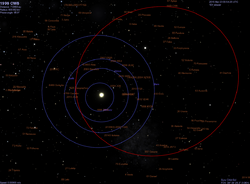Astronomy:1999 CW8
 Screenshot of the orbit of 1999 CW8 in the program Celestia. | |
| Discovery [1] | |
|---|---|
| Discovered by | LINEAR |
| Discovery site | Lincoln Laboratory ETS |
| Discovery date | 12 February 1999 |
| Designations | |
| 1999 CW8 | |
| Minor planet category | NEO · Apollo [1] |
| Orbital characteristics [1] | |
| Epoch 4 September 2017 (JD 2458000.5) | |
| Uncertainty parameter 0 | |
| Observation arc | 10.47 yr (3,823 days) |
| |{{{apsis}}}|helion}} | 3.5762 AU |
| |{{{apsis}}}|helion}} | 0.8956 AU |
| 2.2359 AU | |
| Eccentricity | 0.5994 |
| Orbital period | 3.34 yr (1,221 days) |
| Mean anomaly | 176.81° |
| Mean motion | 0° 17m 41.28s / day |
| Inclination | 33.641° |
| Longitude of ascending node | 317.03° |
| 262.07° | |
| Earth MOID | 0.2323 AU · 90.5 LD |
| Mars MOID | 0.07356 AU [2] |
| Physical characteristics | |
| Dimensions | 0.64 km (generic at 0.159)[3] |
| SMASS = B [1] | |
| Absolute magnitude (H) | 18.6[1] |
1999 CW8 is a bright carbonaceous asteroid and sub-kilometer near-Earth object of the Apollo group, first observed on 12 February 1999, by astronomers of the Lincoln Near Earth Asteroid Research program at Lincoln Laboratory ETS in New Mexico, United States.[2]
Description
1999 CW8 is a B-type asteroid, relatively rare in the asteroid belt but common in the inner Solar System. The asteroid never approaches Earth closer than 0.2 AU, but occasionally makes close approaches to Mars of 0.07 AU. It makes one such approach in 2073, at 0.067 AU, and another one in 2103, at 0.094 AU. Due to 1999 CW8's relatively high inclination, although it passes closer to the Sun than the Earth (0.9 AU), it never comes closer than 0.2 AU.
Based on an absolute magnitude of 18.6, and an assumed albedo of 0.159 (derived from the B-type asteroid 2 Pallas), the asteroid can be estimated to have a mean-diameter of approximately 640 meters.[3] If it impacted the Earth would cause significant damage, but not as much as the Cretaceous–Paleogene extinction event progenitor, which brought about a mass extinction, as it is only 1/20 to 1/10 the size. However, it is unlikely to come close enough to Earth to impact it, or even become a risk of impact.
See also
- Mars-crossing asteroid
References
- ↑ 1.0 1.1 1.2 1.3 1.4 "JPL Small-Body Database Browser: (1999 CW8)". Jet Propulsion Laboratory. http://ssd.jpl.nasa.gov/sbdb.cgi?sstr=3019066. Retrieved 16 October 2017.
- ↑ 2.0 2.1 "1999 CW8". Minor Planet Center. http://www.minorplanetcenter.net/db_search/show_object?object_id=1999+CW8. Retrieved 16 October 2017.
- ↑ 3.0 3.1 "Asteroid Size Estimator". CNEOS – NASA/JPL. https://cneos.jpl.nasa.gov/tools/ast_size_est.html. Retrieved 16 October 2017.
External links
- 1999 CW8 at the JPL Small-Body Database


